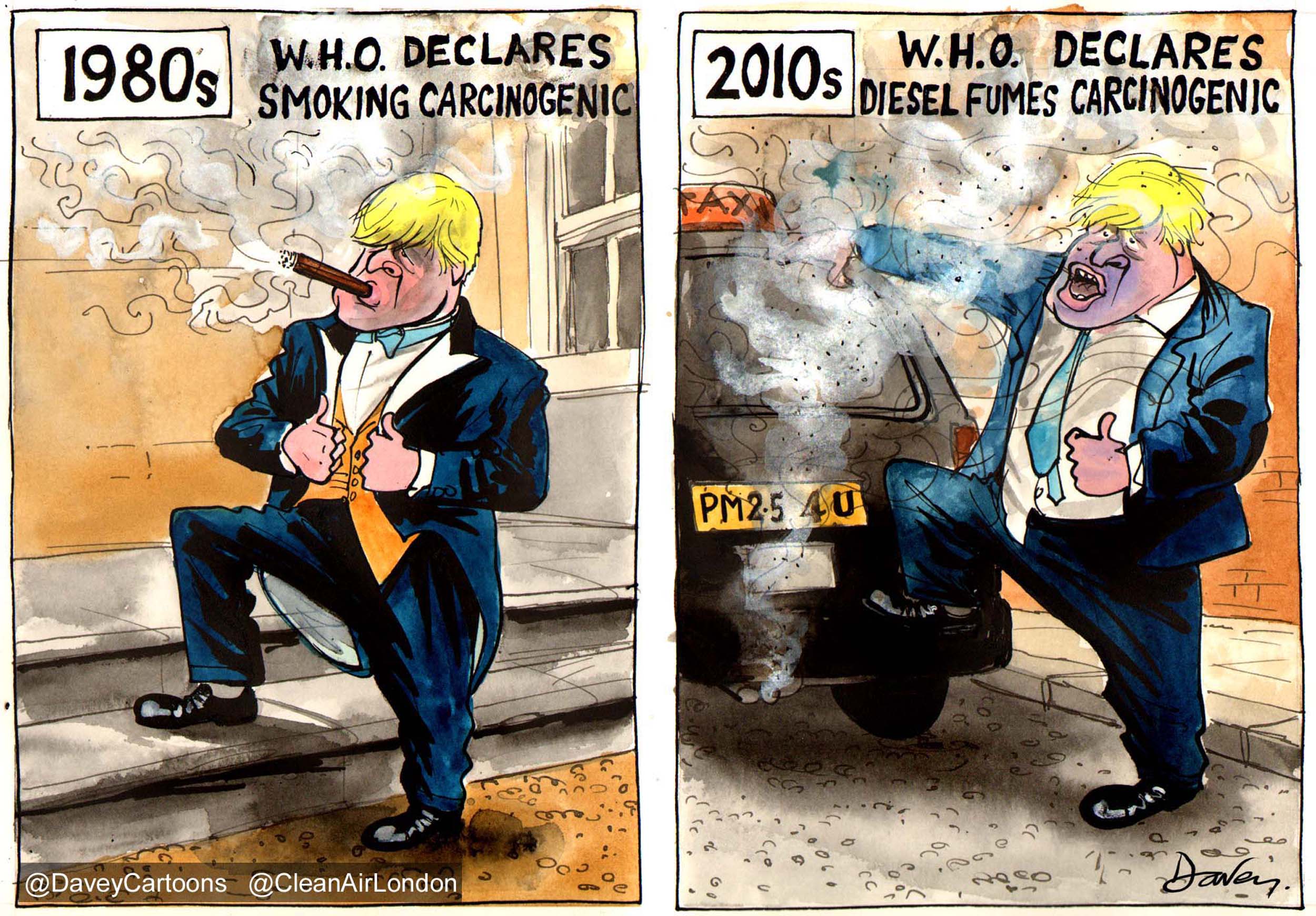Air pollution is the world’s largest environmental health risk killing an estimated seven million people every year.
World Health Organisation has halved air quality guidelines for fine particles (PM2.5) and slashed those for nitrogen dioxide (NO2) by 75%.
‘Good practice statements’ published for black carbon, ultra fine particles (UFP) and sand and dust storms. The benchmarks for UFP will be important for the monitoring and management of indoor air quality.
WHO estimates that full compliance with the new air quality guidelines could save three million lives a year from outdoor air pollution and a further 2.5 million a year from household air pollution i.e. an 80% reduction in the burden of disease.
The new WHO air quality guidelines (AQGs) have been through an incredibly thorough and systematic review which began in 2016.
The new AQGs are much needed because so much science has built up, warning about the dangers of air pollution, since the current ones were published in 2006.
Key changes include the annual and daily mean AQGs for fine particles (PM2.5) and nitrogen dioxide (NO2) being reduced to five and 15 micrograms per cubic metre (from 10 and 25 ug/m3) and to 10 and 25 ug/m3 (from 40 and 200 ug/m3) respectively. There should be no more than three to four exceedances days per year of the daily guidelines. The NO2 1-hour AQG of 200 ug/m3 was not re-evaluated and remains valid.
The WHO has recommended new AQGs for ozone (O3), carbon monoxide (CO) and sulphur dioxide (SO2) of 60 ug/m3 (average daily concentrations over the peak six months) and 100 ug/m3 (8-hour), 4 ug/m3 (over 24 hours) and 40 ug/m3 (over 24-hours) respectively.
Bold action will be needed to comply with the new AQGs as it was after 2006. For example, nitrogen dioxide (NO2) in Marylebone Road in London in 2006 was:
- Annual mean 111 ug/m3 (compared to the WHO AQG and legal limit of 40)
- Exceedance hours 665 (compared to the WHO AQG of zero and the legal limit of 18)
Concentrations and exceedances in Brixton Road and Putney High Street were much higher.
The WHO has issued ‘Good practice statements’ for black carbon (BC/EC), ultrafine particles (UFP) and sand and dust storms (SDS). They state that particle number counts (PNCs) for UFPs can be considered LOW < 1,000 particles/cm3 (24-hour mean) and HIGH > 10,000 particles/m3 (24-hour mean) or > 20,000 particles/m3 (1-hour mean) (for particle sizes over 10 nanometres). These levels will be important for the management of indoor air quality.
About 80% of the sources of local air pollutants and greenhouse gases are the same. The need for action to protect public health and fight climate change both point to zero air emission solutions as soon as possible.
We must also tackle non-combustion sources of local air pollution such as ammonia from agriculture which forms particles in the air and travels long distances.
The new AQGs must be put in law now as they were in 1999 and 2007. We need full compliance with the WHO’s new AQGs, urgently and sustainably.
Quote
Simon Birkett, Founder and Director of Clean Air in London, said:
“The WHO’s new AQGs are a stark reminder of the dangers of air pollution and how much further we need to go to reduce it.
“The good news, weeks before COP26, is that climate and air quality policies all point to achieving zero air emissions in cities and towns by 2030 and sharply reducing pollution from other sources such as red meat eating, aviation and shipping.
“After nearly succeeding in Clean Air in London’s 15-year mission to achieve full compliance with World Health Organisation air quality guidelines throughout London, the WHO has put me to work again!”
ENDS
Useful links and resources
1. World Health Organisation publications and resources about new AQGs
https://apps.who.int/iris/handle/10665/345329
https://apps.who.int/iris/handle/10665/345334
CAL 423 New WHO AQGs Executive Summary 220921
https://www.who.int/health-topics/air-pollution#tab=tab_1
2. World Health Organisation press conference and livestream
https://breathelife2030.org/news/w-h-o-air-quality-guidelines/
https://www.who.int/health-topics/air-pollution#tab=tab_1
https://www.healtheffects.org/sites/default/files/jarosinska-who-guidelines-hei-2021.pdf
Evolution of WHO air quality guidelines 2017
https://www.euro.who.int/__data/assets/pdf_file/0019/331660/Evolution-air-quality.pdf
3. Clean Air in London Twitter thread
https://twitter.com/CleanAirLondon
https://twitter.com/CleanAirLondon/status/1438469950449061890?s=20
https://twitter.com/CleanAirLondon/status/1389595736703217664?s=20
4. Clean Air in Cities app
https://cleanair.london/cleanaircities/
5. Health Effects Institute annual conference and statements by health scientists
https://www.iseepi.org/docs/Final_WHO_AQG_Joint_Statement.pdf
https://www.ersnet.org/news-and-features/news/urge-implement-air-pollution-policies-who-aqgs/
https://www.ssph-journal.org/articles/10.3389/ijph.2021.1604465/full
https://www.healtheffects.org/annual-conference
https://www.healtheffects.org/sites/default/files/jarosinska-who-guidelines-hei-2021.pdf
6. European Commission revision of the Air Quality Directive
Stakeholder event 23 September 2021
Consultation closing 16 December 2021
7. Lessons from previous revisions of the Air Quality Directive
12 May 2007
https://cleanair.london/health/setting-and-enforcing-european-union-legal-limits-for-air-quality/
12 December 2007
30 September 2011
18 April 2013
8. Air pollution in London
Brixton Road in 2004 (nitrogen dioxide)
Annual mean 197 micrograms per cubic metre (ug/m3)
Hourly exceedances 3,845
2007 (4,229 hours)
2014 (153 ug/m3 and 2,001 hours)
Marylebone Road in 2006 (annual 111 ug/m3 and 665 hours)
Putney High Street in 2012 (annual 155 ug/m3 and 2,740 hours)
Oxford Street in 2014 (1,532 hours)
https://www.londonair.org.uk/london/asp/news.asp?NewsId=OxfordStHighNO2
9. Sources of local air pollutants and greenhouse gases
https://www.gov.uk/government/statistical-data-sets/env01-emissions-of-air-pollutants
https://cleanair.london/app/uploads/CAL-submission-re-Agriculture-Bill-2019_180220.pdf
https://www.care4air.org/air-pollutants/greenhouse-gases/
10. Solutions
Ban the use of wood burning appliances including fireplaces in urban areas.
Implement international best practices for the control of ammonia in farming (Part 2, Annex III, NECD 2016)
https://eur-lex.europa.eu/legal-content/EN/TXT/PDF/?uri=CELEX:32016L2284&from=EN
Introduce emissions based road user charging to slash diesel emissions
They should also:
Warn people properly about air pollution episodes.
Put these new guidelines in a new Clean Air Act and the Environment Bill
11. Indoor air
https://cleanair.london/indoor-air/
12. Ella Roberta Adoo Kissi-Debrah
https://cleanair.london/health/ellaslaw/
14. Clean Air Act and Environment Bill
https://cleanair.london/clean-air-act/
https://www.parliament.uk/business/news/2021/june/lords-debates-environment-bill2/
15. Scientific research supporting the new AQGs
https://www.bmj.com/content/374/bmj.n1904
https://www.sciencedirect.com/journal/environment-international/special-issue/10MTC4W8FXJ
https://ars.els-cdn.com/content/image/1-s2.0-S0160412020318316-mmc4.pdf
ENDS
Updated 30 September 2021










